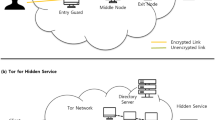Abstract
The scale of mobile wireless networks is increasing sharply. However, many websites in the WAP networks contain obscenity information, viruses, and Trojans. How to crawl, judge and locate these bad websites is a challenging problem. In this article, a WAP bad information detection system is proposed, which contains crawling, judgment and location subsystems to identify bad WAP websites. The distributed crawling is adapted to break the IP limitation of WAP networks. Text and image automatic classification are introduced in the judgment subsystem. The location subsystem can locate the bad sites and collect the evidence. The experiment results verify that our WAP bad information detection system has high efficiency and accuracy.












Similar content being viewed by others
Explore related subjects
Discover the latest articles, news and stories from top researchers in related subjects.References
Mason D, Jose JM, Joseph A (2002) WapSearch: a system for searching the web using WAP enabled devices. In: NDDL, pp 29–38
Roussev V (2009) Hashing and data fingerprinting in digital forensics. IEEE Secur Privacy 7:49–55
Zhu Y (2012) Introducing google chart tools and google maps API in data visualization courses. IEEE Comput Graph Appl 32:6–9
Lin T, Wang K, Liu A (2005) An efficient load balancing strategy for scalable WAP gateways. Comput Commun 28:1028–1037
Agustina JV, Zhang P, Kantola R (2003) Performance evaluation of GSM handover traffic in a GPRS/GSM network. In: ISCC, pp 137–142
Rutagemwa H, Shen X (2003) Modeling and Analysis of WAP Performance over Wireless Links. IEEE Trans Mob Comput 2:221–232
Yu S, Cai D, Wen J, Ma W (2003) Improving pseudo-relevance feedback in web information retrieval using web page segmentation. In: WWW, pp 11–18
Sebastiani F (2002) Machine learning in automated text categorization. ACM Comput Surv 34:1–47
Salton G, Wong A, Yang CS (1975) A vector space model for automatic indexing. Commun ACM 18:613–620
Salton G, Buckley C (1990) Improving retrieval performance by relevance feedback. In: JASIS, pp 288–297
Sharma K, Ghose MK (2011) Cross layer security framework for wireless sensor networks. Int J Security Appl 5(1):35–52
Joachims T (1998) Text categorization with suport vector machines: learning with many relevant features. In: ECML, pp 137–142
Chang C, Lin C (2011) LIBSVM: a library for support vector machines. In: ACM TIST, pp 27–27
Xu J, Wang J, Xie S, Chen W, Kim JU (2013) Study on intrusion detection policy for wireless sensor networks. Int J Security Appl 7(1):1–6
Baohuai S, Jianli W, Ping L (2008) The covering number for some Mercer kernel Hilbert spaces. J Complex 24:241–258
Mitra K, Bhattacharyya D, Sattarova FY, Kim T (2009) A heuristic approach for mobile phone bases information management system in wireless sensor network. Int J Grid Dist Comp 2(3):1–12
Hsu C, Lin C (2002) A comparison of methods for multiclass support vector machines. IEEE Trans Neural Netw 13:415–425
Musznicki B, Zwierzykowski P (2012) Survey of simulators for wireless sensor networks. Int J Grid Dist Comput 5(3):23–50
Salton G, McGill M (1984) Introduction to modern information retrieval. McGraw-Hill Inc., New York
Acknowledgments
This work was supported by the National Basic Research Program of China under Grant No. G2011CB302605, the National Natural Science Foundation of China (NSFC) under grant No. 61173145, and the National High Technology Research and Development Program of China under Grant No. 2011AA010705.
Author information
Authors and Affiliations
Corresponding author
Rights and permissions
About this article
Cite this article
Zhang, W., Zhang, Y. & Kim, TH. Detecting bad information in mobile wireless networks based on the wireless application protocol. Computing 96, 855–874 (2014). https://doi.org/10.1007/s00607-013-0325-1
Received:
Accepted:
Published:
Issue Date:
DOI: https://doi.org/10.1007/s00607-013-0325-1
Keywords
- Mobile wireless network
- Wireless application protocol
- Information crawling
- Text classification
- Image recognition




